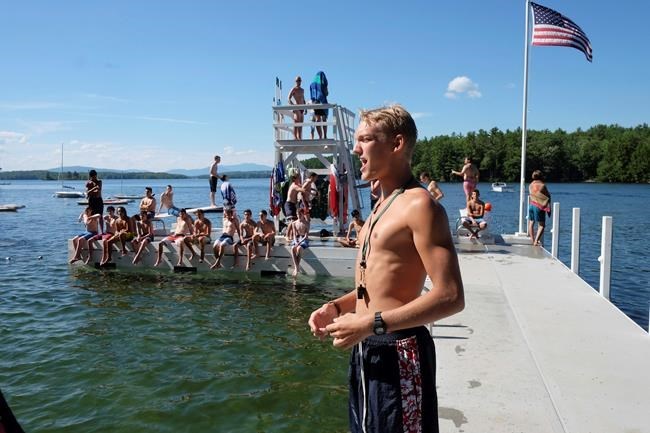
In this summer of 2017 photo, a swim instructor orients his lesson group to a new skill at Camp Belknap's Main Dock on Lake Winnipesaukee, N.H. (YMCA Camp Belknap via AP)
February 06, 2018 - 7:17 AM
Camp swim tests go something like this: Kids jump in the water and swim a set distance. No dog-paddling allowed. They typically must also tread water and float on their backs, while camp staff and possibly other campers look on.
And all this usually on the first day or two of camp.
It can be stressful. Kids who aren't strong swimmers sometimes feel nervous and might not swim their best, says Tom Wraight, waterfront director at Camp Belknap in Mirror Lake, New Hampshire. Pool swimmers can be thrown by a lake's choppy, chilly water, cloudy bottom or lurking critters.
"Swimming in a lake is potentially just mentally scarier," he says.
Wraight usually hears from a parent or two who received a disappointed letter home about swim-test results. Kids who are restricted to shallow water or are deemed non-swimmers can feel embarrassed, though Wraight says they typically recover quickly.
"There's always a few tears, which is always unfortunate," he says. "We remind them that everyone was there at some point."
He and other experts say there are steps parents can take to prepare children and to relieve swim-test anxiety.
For one thing, remember that swimming is only one part of camp.
"I would tell parents who are maybe dreading the fact that their kid might not pass the swim test . it's not the end of the world because there are just so many other activities," says parent Laura Gogia. Last summer, her daughter Lindsay, 10, placed in the lowest swim group at a camp near their home in Richmond, Virginia. So Lindsay opted for other activities, such as joining kids making friendship bracelets by the lake.
Eventually, she got bored as one of the oldest kids in the shallow area and longed to use a zip line over deep water, and that motivated her to give swimming lessons another try over the winter. She clicked with a young, gentle-mannered instructor who tailored one-on-one lessons to the swim test.
Here are some other pointers from experts for parents preparing children for a camp swim check:
1. Tell your child in detail what to expect. Kids who aren't prepared have a harder time.
2. Ask your child to set a goal, adjust your expectations accordingly and try to provide practice time.
3. Find out the policy for retaking the test or advancing through lessons. Wraight says Camp Belknap encourages kids to take lessons during camp to try to progress through swim levels.
4. If you can, enrol your kid in swimming lessons — private or group — in the winter or spring, and let the instructor know about swim test goals.
5. Consider refresher lessons for kids who swim consistently only in summer.
6. Check around for reduced-rate or free instruction or pool membership, which the Y offers. Or take your children swimming for fun and ask a lifeguard for skills to practice on your own.
7. Don't rule out camp just because your child hasn't taken swim lessons or won't pass the test. Many kids find their motivation to learn to swim at camp.
Camps administer swim checks for safety, to prevent water injuries and deaths, says Lindsay Mondick, the Minneapolis-based senior manager of aquatics for the national Y. The Y updated its swimming lesson curriculum in 2016 to increase the emphasis on drowning prevention.
One skill, called "swim, float, swim," has a goal similar to that of many camp swim tests: that children orient their bodies toward safety and swim for it, taking breaks to avoid tiring out and then starting up again.
"If a child feels they have more control of their body, they will be more willing and achieve strokes faster," Mondick says.
The Boy Scouts have a standard swim test, and the Y offers its locations a sample test. But overall, requirements vary somewhat among camps.
Generally, swimming without stopping for a predetermined length — 50 yards or more is common for deep-water competency — shows endurance to reach safety. Test givers don't expect competition-level strokes, but kids should stay at the top of the water, lift their faces out to breath, kick steadily and keep moving forward.
News from © The Associated Press, 2018